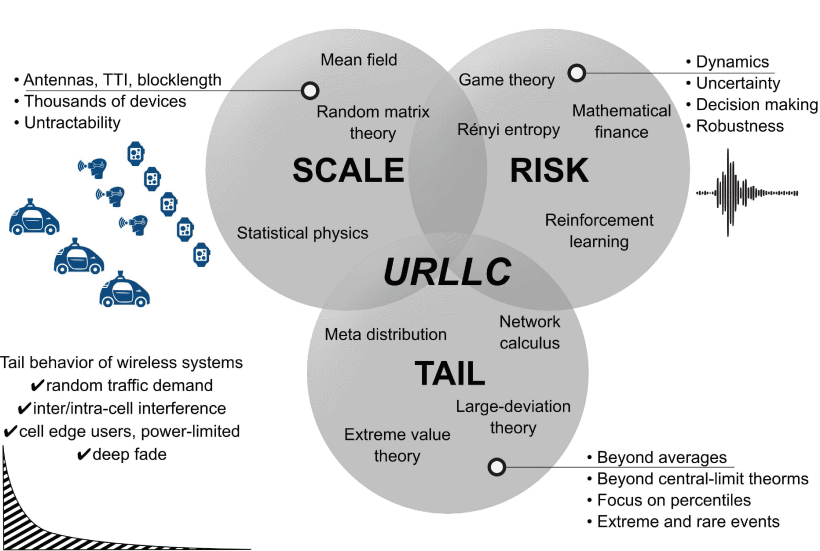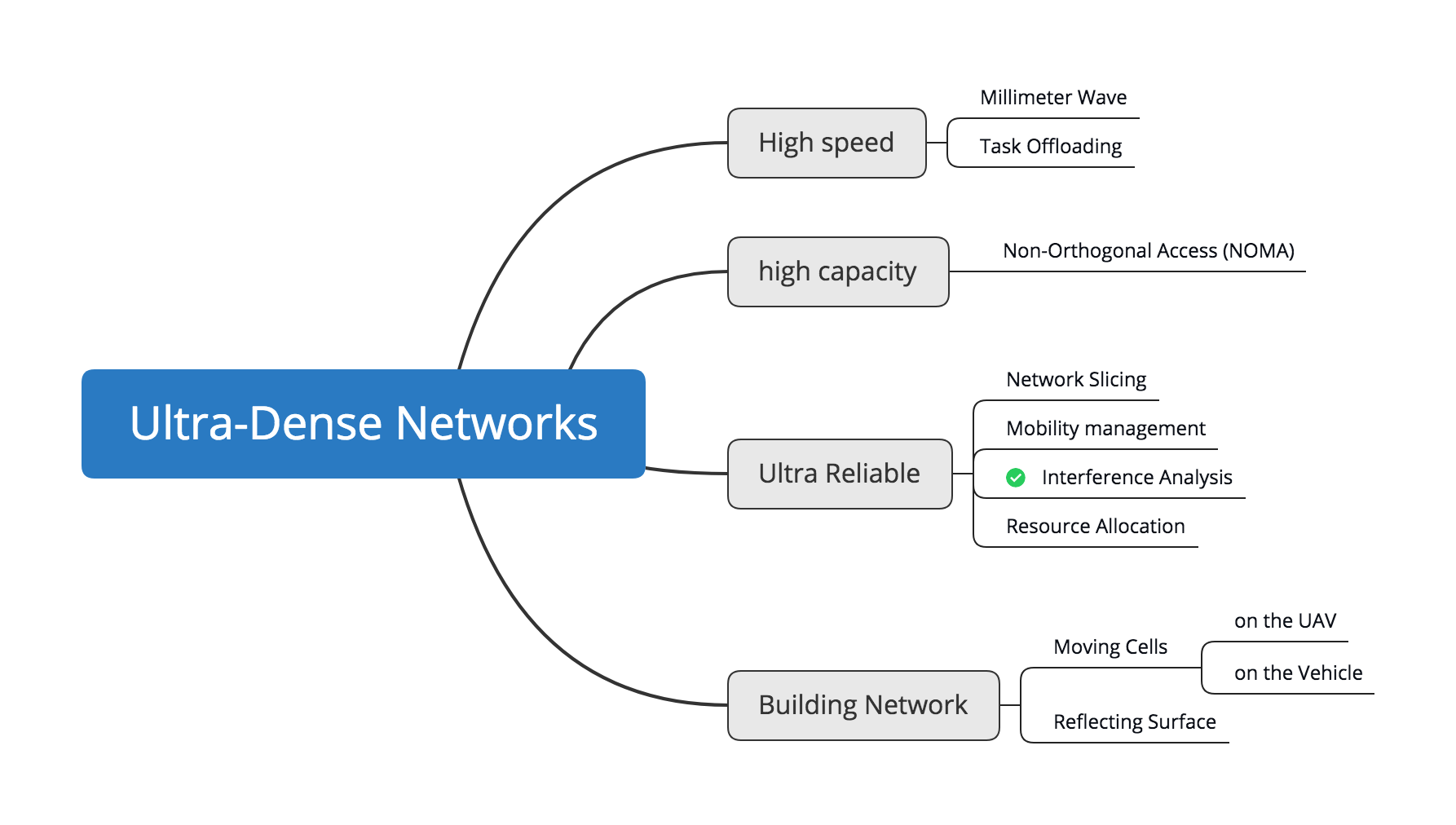TTUXL.github.io
Ultra-Dense Networks Notes
I have two Questions.
What do I need to do this semester?
- write a paper follow Jeffrey G.Andrews.
- write a UDN Survey to summarize what learning this semester.
If I read this [1] kind of mathematical proof articles, it should be read from new article to old article, or from old to new?
Merouane Debbah H index=78
Centralesupelec
Cited by 145. Bennis, Mehdi, Mérouane Debbah, and H. Vincent Poor. “Ultrareliable and low-latency wireless communication: Tail, risk, and scale.” Proceedings of the IEEE 106.10 (2018): 1834-1853.[2]
The main points:
URLLC can be broken down into three major building blocks, namely: 1) risk; 2) tail; and 3) scale.
Risk: It is naturally encountered when dealing with decision making under uncertainty, when channels are time-varying and in the presence of network dynamics. Here, decentralized or semi-centralized algorithms providing performance guarantees and robustness are at stake, and notably game theory and reinforcement learning.
Tail: The notion of tail behavior in wireless systems is inherently related to the tail of random traffic demand, tail of latency distribution, intra/inter-cell interference, and users that are at the cell edge, power-limited or in deep fade. In this regard, extreme value theory, mathematical finance and network calculus are important methodologies.
Scale: This is motivated by the sheer amount of devices, antennas, sensors and other nodes which pose serious challenges in terms of resource allocation and network design. For this purpose, mean field (and mean field game) theory, statistical physics and random matrix theory are important tools.

various enablers for low-latency communication
- Short transmission time interval (TTI), short frame structure, and hybrid automatic repeat request (HARQ);
- eMBB/URLLC multiplexing;
- Edge caching, computing, and slicing;
- On-device machine learning and artificial intelligence (AI) at the network edge;
- Grant-free versus grant-based access;
- Nonorthogonal multiple access (NOMA);
- Low/medium-earth orbit (LEO/MEO) satellites and unmanned aerial vehicles (UAVs);
- Joint flexible resource allocation for uplink/downlink;
The main factors affecting reliability stem from:
- collisions with other users due to uncoordinated channel access;
- coexistence with other systems in the same frequency bands;
- interference from users in adjacent channels;
- Doppler shifts from moving devices;
- difficulty of synchronization, outdated channel state information, time-varying channel effects or delayed packet reception.

High Citation:
Survey
[1] Yadav, Animesh, and Octavia A. Dobre. “All technologies work together for good: A glance at future mobile networks.” IEEE Wireless Communications 25.4 (2018): 10-16.
[2] Zhong, Yi, et al. “Traffic matching in 5G ultra-dense networks.” IEEE Communications Magazine 56.8 (2018): 100-105.
[3] Wang, Lifeng, et al. “A new look at physical layer security, caching, and wireless energy harvesting for heterogeneous ultra-dense networks.” IEEE Communications Magazine 56.6 (2018): 49-55.
[4] Gao, Zhen, et al. “Compressive sensing techniques for next-generation wireless communications.” IEEE Wireless Communications 25.3 (2018): 144-153.
[5] Boulogeorgos, Alexandros-Apostolos A., et al. “Terahertz technologies to deliver optical network quality of experience in wireless systems beyond 5G.” IEEE Communications Magazine 56.6 (2018): 144-151.
[6] Pan, Cunhua, et al. “User-centric C-RAN architecture for ultra-dense 5G networks: Challenges and methodologies.” IEEE Communications Magazine 56.6 (2018): 14-20.
[7] Cui, Qimei, et al. “Preserving reliability of heterogeneous ultra-dense distributed networks in unlicensed spectrum.” IEEE Communications Magazine 56.6 (2018): 72-78.
[8] Yadav, Animesh, and Octavia A. Dobre. “All technologies work together for good: A glance at future mobile networks.” IEEE Wireless Communications 25.4 (2018): 10-16.
[9] Li, Yuzhou, et al. “Ultra-dense hetnets meet big data: Green frameworks, techniques, and approaches.” IEEE Communications Magazine 56.6 (2018): 56-63.
[10] Ding, Ming, et al. “On the fundamental characteristics of ultra-dense small cell networks.” IEEE Network 32.3 (2018): 92-100.
[11] Andreev, Sergey, et al. “Future of ultra-dense networks beyond 5G: harnessing heterogeneous moving cells.” IEEE Communications Magazine (2019).
[12]Shi, Yuanming, et al. “Generalized sparse and low-rank optimization for ultra-dense networks.” IEEE Communications Magazine 56.6 (2018): 42-48.
[13] Liu, Jin, et al. “Initial access, mobility, and user-centric multi-beam operation in 5G new radio.” IEEE Communications Magazine 56.3 (2018): 35-41.
Reflecting Surface
[1] Wu, Qingqing, and Rui Zhang. “Intelligent reflecting surface enhanced wireless network: Joint active and passive beamforming design.” 2018 IEEE Global Communications Conference (GLOBECOM). IEEE, 2018.
[2] Lu, Xiao, et al. “Ambient backscatter assisted wireless powered communications.” IEEE Wireless Communications 25.2 (2018): 170-177.
[3] Qingqing, Wu, and Zhang Rui. “Towards smart and reconfigurable environment: Intelligent reflecting surface aided wireless network.” arXiv preprint arXiv:1905.00152 (2019).
Resource Management
[1] Cao, Jiaqi, et al. “Interference management in ultradense networks: A user-centric coalition formation game approach.” IEEE Transactions on Vehicular Technology 67.6 (2018): 5188-5202.
[2] Demarchou, Eleni, Constantinos Psomas, and Ioannis Krikidis. “Mobility management in ultra-dense networks: Handover skipping techniques.” IEEE Access 6 (2018): 11921-11930.
[3] Teng, Yinglei, et al. “Resource allocation for ultra-dense networks: A survey, some research issues and challenges.” IEEE Communications Surveys & Tutorials (2018).
[4] Abedin, Sarder Fakhrul, et al. “Resource allocation for ultra-reliable and enhanced mobile broadband IoT applications in fog network.” IEEE Transactions on Communications 67.1 (2018): 489-502.
[5] Pan, Cunhua, et al. “Joint pilot allocation and robust transmission design for ultra-dense user-centric TDD C-RAN with imperfect CSI.” IEEE Transactions on Wireless Communications 17.3 (2018): 2038-2053.
[6] Pan, Cunhua, et al. “Joint pilot allocation and robust transmission design for ultra-dense user-centric TDD C-RAN with imperfect CSI.” IEEE Transactions on Wireless Communications 17.3 (2018): 2038-2053.
[7] Yang, Bin, et al. “On the energy-efficient deployment for ultra-dense heterogeneous networks with NLoS and LoS transmissions.” IEEE Transactions on Green Communications and Networking 2.2 (2018): 369-384.
[8] Zhang, Hongtao, et al. “Flexible Coverage for Backhaul-Limited Ultradense Heterogeneous Networks: Throughput Analysis and $\eta $-Optimal Biasing.” IEEE Transactions on Vehicular Technology 67.5 (2018): 4161-4172.
Task Offloading
[1] Chen, M and Hao, Y. “Task offloading for mobile edge computing in software defined ultra-dense network.” IEEE Journal on Selected Areas in … ieeexplore.ieee.org, 2018
[2] Xu, Jie, Lixing Chen, and Pan Zhou. “Joint service caching and task offloading for mobile edge computing in dense networks.” IEEE INFOCOM 2018-IEEE Conference on Computer Communications. IEEE, 2018.
[3] Guo, Hongzhi, et al. “Mobile-edge computation offloading for ultradense IoT networks.” IEEE Internet of Things Journal 5.6 (2018): 4977-4988.
[4] Tran, Tuyen X., and Dario Pompili. “Joint task offloading and resource allocation for multi-server mobile-edge computing networks.” IEEE Transactions on Vehicular Technology 68.1 (2018): 856-868.
[5] Chen, Min, et al. “Edge-CoCaCo: Toward joint optimization of computation, caching, and communication on edge cloud.” IEEE Wireless Communications 25.3 (2018): 21-27.
[6] Chen, Min, et al. “Label-less learning for traffic control in an edge network.” IEEE Network 32.6 (2018): 8-14.
[7] Qiao, Guanhua, et al. “Collaborative task offloading in vehicular edge multi-access networks.” IEEE Communications Magazine 56.8 (2018): 48-54.
[8] Chen, Xianfu, et al. “Performance optimization in mobile-edge computing via deep reinforcement learning.” 2018 IEEE 88th Vehicular Technology Conference (VTC-Fall). IEEE, 2018.
[9] Ouyang, Tao, Zhi Zhou, and Xu Chen. “Follow me at the edge: Mobility-aware dynamic service placement for mobile edge computing.” IEEE Journal on Selected Areas in Communications 36.10 (2018): 2333-2345.
[10] Qiao, Guanhua, et al. “Collaborative task offloading in vehicular edge multi-access networks.” IEEE Communications Magazine 56.8 (2018): 48-54.
[11] Zhang, Hongliang, Lingyang Song, and Ying Jun Zhang. “Load balancing for 5G ultra-dense networks using device-to-device communications.” IEEE Transactions on Wireless Communications 17.6 (2018): 4039-4050.
[12] Guo, Hongzhi, Jiajia Liu, and Jie Zhang. “Computation offloading for multi-access mobile edge computing in ultra-dense networks.” IEEE Communications Magazine 56.8 (2018): 14-19.
Non-Orthogonal Access
[1] Qin, Zhijin, et al. “User association and resource allocation in unified NOMA enabled heterogeneous ultra dense networks.” IEEE Communications Magazine 56.6 (2018): 86-92.
[2] Marshoud, Hanaa, et al. “Optical non-orthogonal multiple access for visible light communication.” IEEE Wireless Communications 25.2 (2018): 82-88.
[3] Wang, Qi, et al. “Non-orthogonal multiple access: A unified perspective.” IEEE Wireless Communications 25.2 (2018): 10-16.
[4] Wang, Qi, et al. “Non-orthogonal multiple access: A unified perspective.” IEEE Wireless Communications 25.2 (2018): 10-16.
Network Slicing
[1] Afolabi, I, Taleb, T, Samdanis, K and …. “Network slicing and softwarization: A survey on principles, enabling technologies, and solutions.” … Surveys & Tutorials ieeexplore.ieee.org, 2018
[2] Kaloxylos, Alexandros. “A survey and an analysis of network slicing in 5G networks.” IEEE Communications Standards Magazine 2.1 (2018): 60-65.
Air-Ground Integrated
[1] Liu, J, Shi, Y, Fadlullah, ZM and Kato, N. “Space-air-ground integrated network: A survey.” … Communications Surveys & … ieeexplore.ieee.org, 2018
[2] Wang, Haichao, et al. “Power control in UAV-supported ultra dense networks: Communications, caching, and energy transfer.” IEEE Communications Magazine 56.6 (2018): 28-34.
[3] Cheng, Nan, et al. “Air-ground integrated mobile edge networks: Architecture, challenges, and opportunities.” IEEE Communications Magazine 56.8 (2018): 26-32.
[4] Alzenad, Mohamed, et al. “FSO-based vertical backhaul/fronthaul framework for 5G+ wireless networks.” IEEE Communications Magazine 56.1 (2018): 218-224.
[5] Fotouhi, Azade, et al. “Survey on uav cellular communications: Practical aspects, standardization advancements, regulation, and security challenges.” IEEE Communications Surveys & Tutorials (2019).
[5] Wang, Yuyang, et al. “MmWave vehicle-to-infrastructure communication: Analysis of urban microcellular networks.” IEEE Transactions on Vehicular Technology 67.8 (2018): 7086-7100.
[6] Azari, Mohammad Mahdi, Fernando Rosas, and Sofie Pollin. “Reshaping cellular networks for the sky: Major factors and feasibility.” 2018 IEEE International Conference on Communications (ICC). IEEE, 2018.
[7] Azari, M. Mahdi, Fernando Rosas, and Sofie Pollin. “Cellular connectivity for UAVs: Network modeling, performance analysis and design guidelines.” IEEE Transactions on Wireless Communications (2019).
Ultrareliable and Low-Latency
[1] Parvez, I, Rahmati, A, Guvenc, I and …. “A survey on low latency towards 5G: RAN, core network and caching solutions.” … Surveys & Tutorials ieeexplore.ieee.org, 2018
[2] Bennis, Mehdi, Mérouane Debbah, and H. Vincent Poor. “Ultra reliable and low-latency wireless communication: Tail, risk, and scale.” Proceedings of the IEEE 106.10 (2018): 1834-1853.
[3] Popovski, Petar, et al. “Wireless access for ultra-reliable low-latency communication: Principles and building blocks.” Ieee Network 32.2 (2018): 16-23.
[4] Hu, Yulin, M. Cenk Gursoy, and Anke Schmeink. “Relaying-enabled ultra-reliable low-latency communications in 5G.” IEEE Network 32.2 (2018): 62-68.
[5] Rao, Jaya, and Sophie Vrzic. “Packet duplication for URLLC in 5G: Architectural enhancements and performance analysis.” IEEE Network 32.2 (2018): 32-40.
[6] Yang, Guang, Ming Xiao, and H. Vincent Poor. “Low-latency millimeter-wave communications: Traffic dispersion or network densification?.” IEEE Transactions on Communications 66.8 (2018): 3526-3539.
[7] Sutton, Gordon J., et al. “Enabling ultra-reliable and low-latency communications through unlicensed spectrum.” IEEE Network 32.2 (2018): 70-77.
[8] She, Changyang, et al. “Improving network availability of ultra-reliable and low-latency communications with multi-connectivity.” IEEE Transactions on Communications 66.11 (2018): 5482-5496.
Deep Learning
[1] Huang, Hongji, et al. “Deep-learning-based millimeter-wave massive MIMO for hybrid precoding.” IEEE Transactions on Vehicular Technology 68.3 (2019): 3027-3032.
[2] Amiri, Roohollah, et al. “A machine learning approach for power allocation in HetNets considering QoS.” 2018 IEEE International Conference on Communications (ICC). IEEE, 2018.
[3] Dai, Yueyue, et al. “Blockchain and deep reinforcement learning empowered intelligent 5g beyond.” IEEE Network 33.3 (2019): 10-17.
[4] Zhou, Yibo, et al. “A deep-learning-based radio resource assignment technique for 5G ultra dense networks.” IEEE Network 32.6 (2018): 28-34.
[5] Fu, Yu, et al. “Artificial intelligence to manage network traffic of 5G wireless networks.” IEEE Network 32.6 (2018): 58-64.